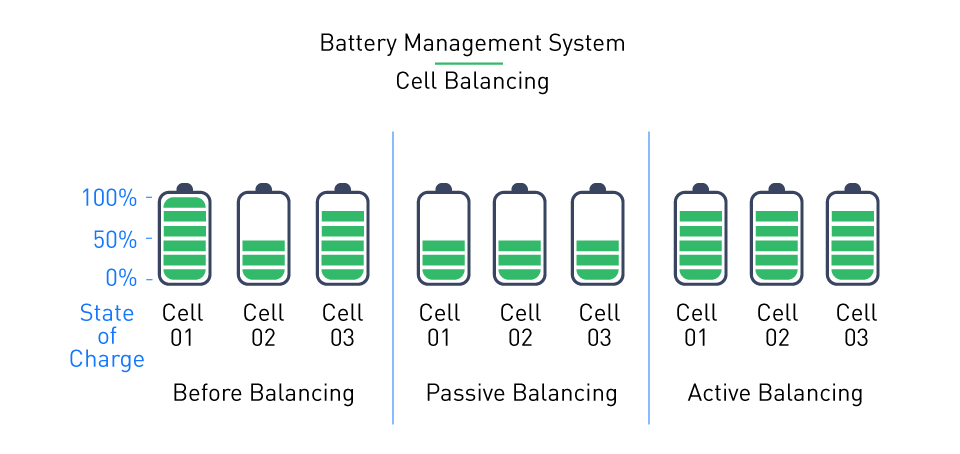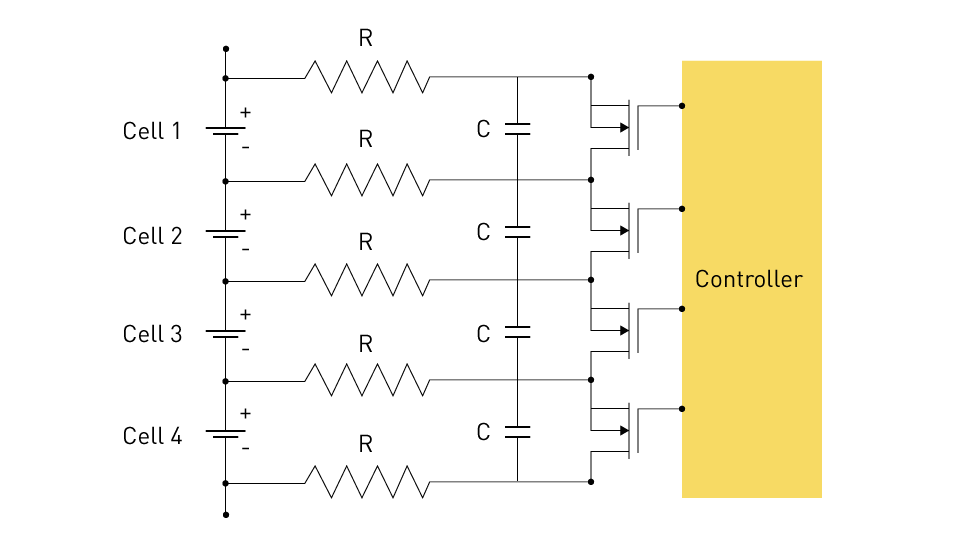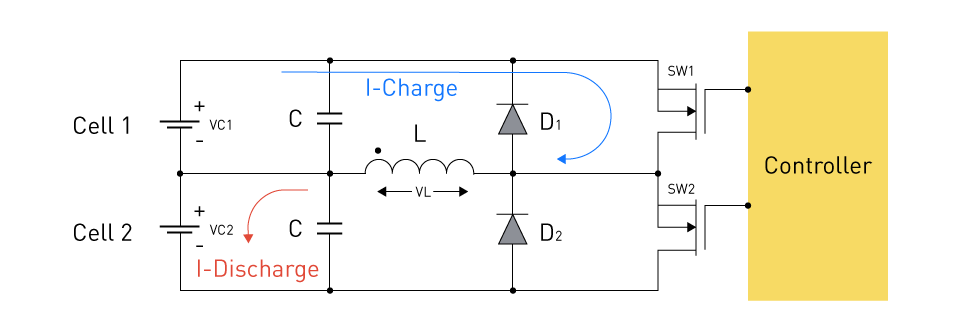Battery Balancing: A Crucial Function of Battery Management Systems

Get valuable resources straight to your inbox - sent out once per month
We value your privacy
In the world of rechargeable batteries, one function of the Battery Management System (BMS) stands out as essential for improving performance and longevity, especially for the batteries used in high-demand applications like electric vehicles and renewable energy storage. This function is battery balancing. This article explores the nuances of battery balance, as well as its significance and role in the effective running of battery systems.

Figure 1. Battery Management System
Understanding Battery Packs and the Need for Balancing
Multiple individual battery cells are connected in series or parallel topologies to obtain the desired voltage and capacity levels in battery packs, which are used in a variety of applications from electric vehicles to portable devices. Even though these cells may be similar when the battery pack is put up, minute variations in their properties over time might cause imbalances in their state of charge (SOC).
Multiple problems may result from these abnormalities. The useful capacity of the entire pack will be constrained because cells with a lower SOC will reach their lowest voltage quicker than the others during discharge. Higher SOC cells will reach their maximum voltage earlier during charging, increasing the chance of overcharging if the process is continued until all cells have been fully charged. Cells that have been overcharged or over-discharged may live shorter lives and experience safety problems.
Battery balance becomes useful in this situation. Battery balancing maximizes the usable capacity of the pack, prolongs the life of the cells, and averts safety problems associated with overcharging or over-discharging by ensuring all cells in the pack have the same SOC.
The Role of the Battery Management Systems (BMS) in Battery Balancing
Battery balancing depends heavily on the Battery Management System. Every cell in the pack has its voltage (and hence SOC) monitored, and when imbalances are found, the pack's SOC is balanced.
Passive balancing and active balancing are the two basic approaches to battery balancing.
Passive Balancing
Burning off the extra energy in the higher charged cells as heat is the process of passive balancing, often referred to as bleed balancing. When the BMS notices that a cell's voltage reaches a given threshold, resistors are often used to do this. Although this method is straightforward and affordable, it has the potential to be inefficient because extra energy is squandered as heat. It does not thus increase system runtime.

Figure 2. Passive Balancing Schematic
A schematic of a passive balancing mechanism, a key component of battery management systems, see Figure 2. This picture shows how a system can balance an overcharged cell with other cells. Through the use of any switching device, such as MOSFETs, energy from the overcharged cell is dissipated through the bleeder resistor in passive balancing, essentially "bleeding off" the excess charge to a level comparable to the other cells. This procedure is essential for keeping the battery system healthy and long-lasting because it prevents any one cell from becoming overcharged, which could eventually result in a decline in battery performance.
Active Balancing
On the other hand, active balancing entails moving the surplus energy from the higher charged cells to the lower charged cells. Numerous techniques, including capacitive balancing (where the energy is transmitted via a capacitor) and inductive balancing (where the energy is transferred via an inductor), can be used to accomplish this. As it doesn't squander excess energy, active balancing is more effective than passive balancing, but it is also more difficult and expensive.

Figure 3. Active Balancing Schematic
Figure 3 shows an overview of active balancing. By switching the MOSFETs, designated SW1 and SW2, excess charge from CELL1 can be transferred to CELL2 in the diagram above. To make the charge flow from CELL1 into the inductor, switch 1 is first closed. After the inductor has finished charging, switch SW1 is opened and switch SW2 is shut.
The inductor transfers its charge to CELL2 when SW2 is closed. The SW2 is opened and the SW1 is closed to start the process over when the inductor has discharged completely. The SOC between cells is compensated through this method.
Regardless of the technique, battery balancing is an essential BMS function that enhances the efficiency and durability of the battery pack.
Battery Monitor and Battery Balancer
The MP2787 IC is a well-known battery monitor and protector in the world of battery management systems. This IC is unique in that it can watch over and safeguard battery stacks. It accurately detects the voltages of up to 16 series cells while displaying high precision of 5mV. It offers protection from overcurrent, short circuits, under and over voltage, cell low and high temperatures, and die high temperatures. Additionally, it incorporates balancing FETs that have the ability to generate external balancing FETs as well as equalize the mismatched cell.
A bidirectional battery balancer IC like the MP2641 shines as a strong example of active balancing. Since it enables energy to be moved from high-energy cells to lower-energy ones, this buck-boost type battery balancer IC stands out because it improves the effectiveness and longevity of battery systems. With great accuracy, it can handle two series-connected cells while maintaining precise balance across the entire stack. It offers the aforementioned protections in addition to having a 92.8% efficiency.
The Importance of Battery Balancing in Battery Management Systems
For a number of reasons, battery balancing is essential in battery management systems.
Maximizing Usable Capacity
Battery balancing maximizes the useful capacity of the pack by guaranteeing that all cells in the pack have the same SOC. This implies that you can maximize the use of your battery pack whether you're driving an electric car or using a renewable energy storage system to power your home.
Extending Battery Lifespan
The battery pack's longevity is also increased via battery balancing. Battery balancing can prolong the lifespan of the cells by limiting the overcharging and over discharging of individual cells.
Preventing Safety Issues
Battery balancing can also avoid potential safety problems by limiting overcharging and over discharging of particular cells. Overcharged and over discharged cells both run the risk of overheating and even starting a fire.
Balancing Trade-offs
In more sophisticated systems, active balancing may dramatically lengthen battery life and improve operational effectiveness. However, it's critical to balance the advantages with the increased funding needed for such a system.
Active balancing often denotes a more complicated system and higher expense. The cost can go up due to more expensive components, longer development times, larger systems, and perhaps even the requirement for more complicated thermal management methods. As a result, even though active balancing can assure more efficient operation and extend battery life, these benefits must justify the higher initial expenditure and potential rise in operational costs.
It's a careful trade-off that requires careful thought, where the particulars of the application and the system requirements are crucial. The level of balancing required is strongly related to the application; active balancing is frequently cost-effective when battery packs are large, expensive, or mission-critical. In contrast, simpler and less expensive passive balancing may be completely suitable in less demanding applications.
Technological Improvements in BMS
The constant technological developments in the larger field of electronics have long been present in the world of Battery Management Systems (BMS). This is especially clear in the possible optimization of balancing techniques using machine learning (ML) and artificial intelligence (AI).
Large datasets from batteries can be analyzed by ML and AI algorithms while they operate, revealing patterns and correlations that conventional analysis techniques would miss. The performance, health, and lifespan of batteries may then be predicted with an unprecedented level of accuracy using these patterns. As a result, balancing tactics can be dynamically changed in real-time in accordance with the operational circumstances and health of each individual cell, hence improving the performance and longevity of the battery pack.
The development of BMS is also being aided on another front by improvements in active balancing technology. More effective and dependable active balancers are now possible due to advancements in power electronics and circuit design. These balancers can quickly equalize cell voltages without wasting energy as heat. As a result, the overall battery efficiency and operational lifespan are significantly increased.
Furthermore, the development of IoT and connected devices is expanding the potential of BMS. With the ability to communicate real-time data on battery performance with cloud-based systems, remote monitoring, preventive maintenance, and even advanced analytics for further optimization are all made possible. With their contribution to the overall effectiveness and sustainability of energy systems, these improvements portend a bright future for BMS.
Conclusion
Finally, it should be noted that battery balance is a crucial component of battery management systems. It is essential for enhancing battery pack performance and longevity in high-demand applications like electric automobiles and renewable energy storage systems. Battery balancing makes sure we can fully utilize the energy stored in a battery pack while also eliminating any safety issues connected to overcharging or over discharging by maintaining an equal level of charge across all cells in a battery pack. This process, whether it be passive or active, is essential to the effective and secure operation of our battery-powered products. We may anticipate future developments in battery balancing methods as technology advances, resulting in even greater performance and safety.
_______________________
Did you find this interesting? Get valuable resources straight to your inbox - sent out once per month!
技术论坛
 Latest activity 10 months ago
Latest activity 10 months ago
 9 回复
9 回复
 Latest activity 10 months ago
Latest activity 10 months ago
 5 回复
5 回复
 Latest activity 10 months ago
Latest activity 10 months ago
 5 回复
5 回复





直接登录
创建新帐号